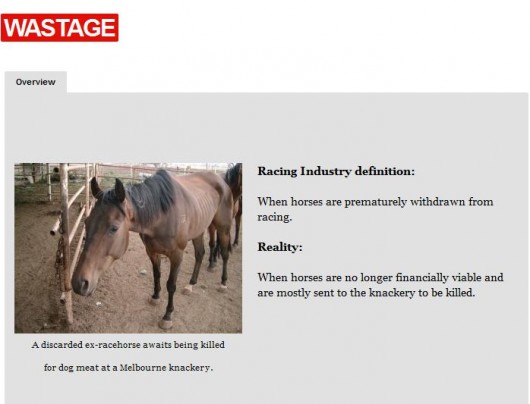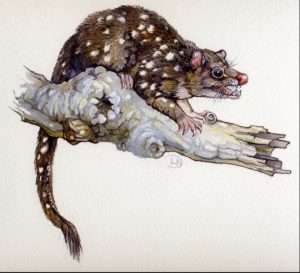Horse Racing breeds immoral knackeries
Thursday, November 15th, 2012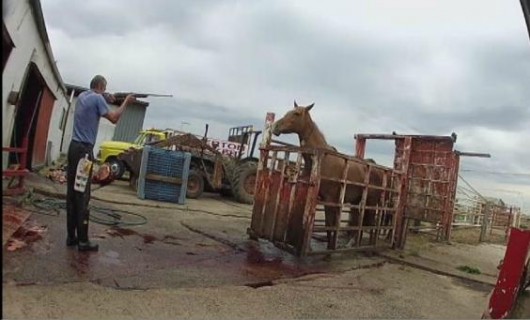 We shoot horses, don’t we?
2012: An Australian shooting a beautiful, intelligent, strong, healthy horse
..just because humans decided that this horse is unprofitable for human exploitive purposes:
We shoot horses, don’t we?
2012: An Australian shooting a beautiful, intelligent, strong, healthy horse
..just because humans decided that this horse is unprofitable for human exploitive purposes:
…Horse Racing!
.
 Horses exploited for gambling
Horses exploited for gambling
.
Introducing The Knacker
.
The Knacker is a person in the trade of rendering horses unfit for human consumption, such as horses that can no longer work. This leads to the slang expression “knackered” meaning very tired, or “ready for the knacker’s yard”, where old horses are slaughtered and made into dog food and glue.
But across Australia, it is not just old horses, but unwanted horses, that are being carted to be slaughtered.
.
Complicit Melbourne Knackeries – worth a peak
(‘Horse Death Camps’ – they arrive not knowing what will become of them, and are slaughtered)
.
- Laverton Knackery, 88-98 Leakes Road, Laverton, Victoria, 3028
- Yarra Glen Knackery, 28 Melba Highway,Yering Victoria, 3770
- Dandenong Knackery, 10 Cahill Street, Dandenong, Victoria, 3175
- Ballarat Knackery, Finch’s Road, Smythes Creek, Victoria, 3351
.
With four knackers serving Melbourne, demand from the Victorian Horse Racing Industry must be significant.
.
‘Moral Universalism’ v ‘Ethical Dilemma’ – ‘Horse Racing’ couldn’t give a…
.
Such primitive and exploitative attitudes toward animals need changing.
‘Putting down‘ a health animal is euphemistic involuntary euthanasia. But such slaughter is inflicted by humans not just upon horses, but upon the entire animal kingdom.
This is what the Nazi’s did to many humans – supposed ‘subhumans’ were judged unworthy of living because they didn’t suit their standards and purpose. It was eupemistically called ‘Eugenics‘.
But what is the moral difference between Nazi selective extermination of unwanted humans and the Horse Racing Industry’s selective extermination of unwanted horses?
Humanity’s treatment of animals remains rationalised nazism, and rationalising is so dangerous that it can make a moral person commit immoral and amoral acts.
.
“Your ability to rationalise your own bad deeds makes you believe that the whole world is as amoral as you are.”
~ Douglas Coupland
.
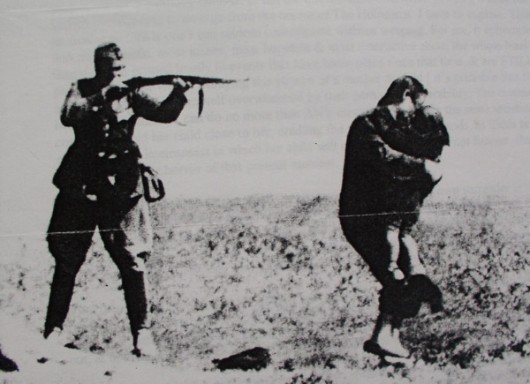 ‘Murder’ or ‘being put down’?
Clearly this is a case of ‘Moral Universalism’ – a gross evil wrong and a disturbing image agreed by all humanity.
It is not a mere ‘Ethical Dilemma’.
Yet 21st Century societies continue to rationalise the exact same treatment of animals as ‘being put down’
and so regarded by the mainstream populous as a mere ‘Ethical Dilemma’.
Complexity is no excuse.
This is rationalised, reinforced, conditioned and ultimately cultural.
‘Murder’ or ‘being put down’?
Clearly this is a case of ‘Moral Universalism’ – a gross evil wrong and a disturbing image agreed by all humanity.
It is not a mere ‘Ethical Dilemma’.
Yet 21st Century societies continue to rationalise the exact same treatment of animals as ‘being put down’
and so regarded by the mainstream populous as a mere ‘Ethical Dilemma’.
Complexity is no excuse.
This is rationalised, reinforced, conditioned and ultimately cultural.
.
<<As long as there have been men on the earth, the struggle between man and the subhuman will be the historic rule; the Jewish-led struggle against the mankind, as far back as we can look, is part of the natural course of life on our planet. One can be convinced with full certainty that this struggle for life and death is just as much a law of nature as is the struggle of an infection to corrupt a healthy body.>>
~ Reichsführer-SS Heinrich Himmler, 1935
The year 1935 was only 77 years ago. Nazi persecutions in Germany were then deliberately and systemically rationalised, reinforced, conditioned and ultimately became cultural across mostly an entire population.
.
Philosophical Quandary:
.
Read about: ^Moral Universalism
Read about: ^Ethical Dilemma
.
Compare the above with:
.
Read about: ^Moral Absolutism
Read about: ^Moral Relativism
.
The Horse Racing Industry is exploitative of horses and immoral towards horses. It engages in horse eugenics, which is immoral.
Horses are intelligent sentient beings. Barbaric practices belong to past centuries. The 21st Century is an advancement beyond past barbarism.
Moral Sense Test: If what is allowed to horses ought to be allowed to human children.
The following television programme aired last night (20121114) on the Australian Broadcasting Corporation reveals the barbaric truth of the exploitative and murderous operations within the Racing Industry in Australia. It reveals that many horses are bred for the Racing Industry, but also that many horses are murdered like fodder.
.
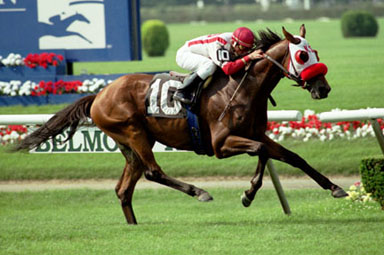 The exciting public image of Thoroughbred Racing
The exciting public image of Thoroughbred Racing
.
‘What happens to failed racehorses?”
.
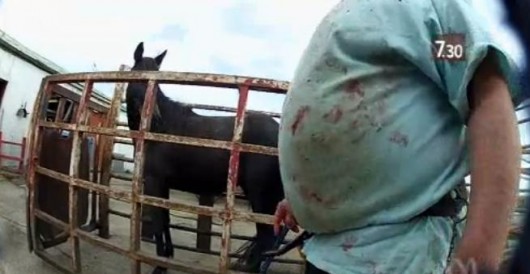 What are you going to do to me?
What are you going to do to me?
.
 Others profit from gamblers on horse racing
Others profit from gamblers on horse racing
.
.
WARNING: The following material includes morally disturbing images/scenes that are highly inappropriate for children to view.
These images/scenes are included in this article in the pursuit of challenging the immorality of prevaling 21st Century cultural reality.
.
.
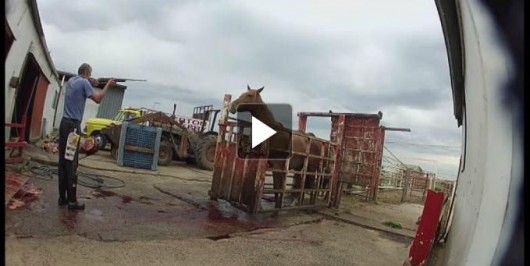 More than 8,000 bred racehorses a year throughout Australia are murdered for dog food
Click image to replay ABC programme:
‘What happens to failed racehorses?’
[Source: ‘What happens to failed racehorses?’, by Guy Stayner (reporter), Australian Broadcasting Corporation, 20121114,
^http://www.abc.net.au/7.30/content/2012/s3632985.htm]
More than 8,000 bred racehorses a year throughout Australia are murdered for dog food
Click image to replay ABC programme:
‘What happens to failed racehorses?’
[Source: ‘What happens to failed racehorses?’, by Guy Stayner (reporter), Australian Broadcasting Corporation, 20121114,
^http://www.abc.net.au/7.30/content/2012/s3632985.htm]
.
<<Owning a racehorse is promoted as an easy way to amass fame and fortune, but very few win any money at all let alone return their training costs and/or purchase price.
When a thoroughbred destined for racing is born in Australia, its chances of being a successful racehorse are slim. It is estimated that only 300 out of every 1000 foals produced will ever start in a race.
.
That means of the 18,000 thoroughbred foals born each year in Australia alone, an average of 12,600 will be ruthlessly discarded and mostly end up at “the doggers.”
.
Of the horses that do race, one Australian Study found that approximately 40% earned no money at all and only 13% earned enough money to cover costs. These figures did not include the initial purchase price. Dr Paul O’Callahan, Chief Veterinary Steward of the Victorian Racing Club states that approximately less than 2% of horses actually earn their keep.>>
.
Breeding
.
While the racing industry argues that many ex-racehorses are sent to stud for breeding, the number of horses involved in breeding has been in steady decline for many years. Since 2000, the number of breeding mares has declined by 12% while stallions have decreased by 30%. That means that for every horse that is sent to stud, at least one leaves. Nearly all the horses that leave the stud will be killed for dog food.
.
Riding Schools, Private ownership
.
Unfortunately, saving ex-racehorses from euthanasia often condemns them to a worse fate, in a downward spiral of abuse and neglect. Few members of the public have the expertise to care for and handle horses properly, let alone understand how much they eat and how expensive it is to feed even one horse, especially during droughts or where the availability of good quality land for agistment is limited. In these situations a horse may have to be fully handfed. Many horses bought as ‘paddock ornaments’ end up totally neglected and left to starve as a result. Horses sold to riding schools or trail riding clubs can lead a miserable existence of hard work, improper care and insufficient feed.
.
‘But a humane and kind retirement for racehorses in some Elysian field (pagan paradise) is largely an urban myth.’
.
A few lucky ones!
.
There is no doubt there are a few lucky horses that are saved by caring individuals and horse rescue shelters. Unfortunately, the numbers are extremely low due to the expensive costs and the time needed in retraining and maintaining a horse. An average healthy horse costs in excess of $4,000 per year.
.
The Doggers and Abattoirs
.
In a business where making a profit is extremely difficult, it is vital to discard a horse as soon as possible after deciding it is no longer viable. To facilitate this, many trainers have arrangements with transport contractors, knackeries or abattoirs that pick up horses on demand. The horses are often picked up at discreet times to spare track workers, strappers, trainers and owners from the guilt of this sad reality.
Younger horses will generally be killed for human consumption in one of Australia’s 2 horse abattoirs located in Caboolture, Queensland and Peterborough, South Australia. Older horses generally end up as dog (food).>>
.
For more information: Search Google Terms: ‘Horse Slaughter‘, ‘Horsemeat: The Facts‘
.
‘Wastage’ – the ‘bycatch‘ of Horse Racing
.
 Unwanted Race Horse on Death Row at the Knackery
Unwanted Race Horse on Death Row at the Knackery
.
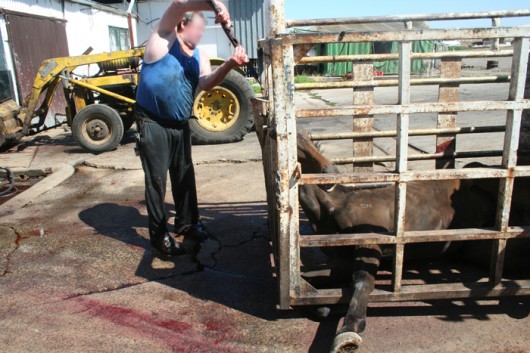 Unwanted Race Horse being murdered at the Knackery
Unwanted Race Horse being murdered at the Knackery
.
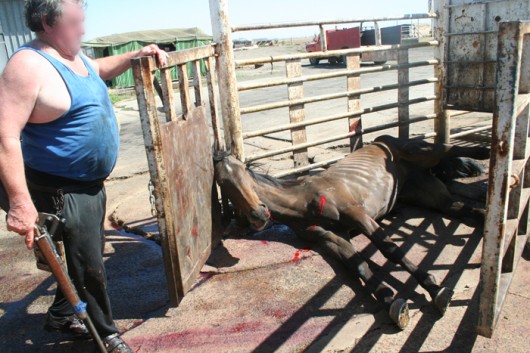 Murdered Race Horse at the Knackery
Murdered Race Horse at the Knackery
.
[Source: The Coalition for the Protection of Race Horses – website, ^http://www.horseracingkills.com/the-issues/wastage/].
The Media Glamour of Horse Racing
.
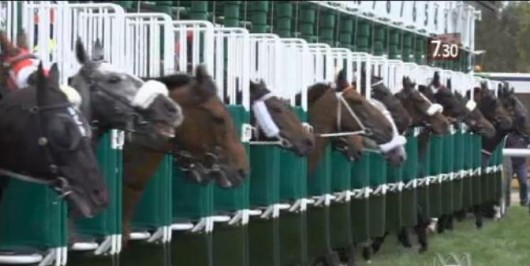 Horse Racing is Immoral – no question
Horse Racing is Immoral – no questionHorse Racing breeds, genetically modifies, exploits, then slaughters horses only so that humans can gamble. Horse Racing is not a sport, just as Cock Fighting and Badger Baiting are clearly not sports. True Sport is a fair contest involving human physical exertion. Animal use is not sport but exploitation. Never bet on a horse race in respect to horses on principle
.
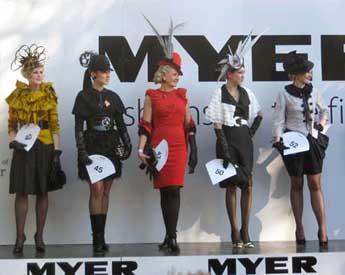 Victorian Racing’s Oak’s Day Fashion
Part of the promotion of race going
…as ethical as wearing fur coats
Victorian Racing’s Oak’s Day Fashion
Part of the promotion of race going
…as ethical as wearing fur coats
.
 No shortage of profiteers from gamblers on horse racing
No shortage of profiteers from gamblers on horse racing
.
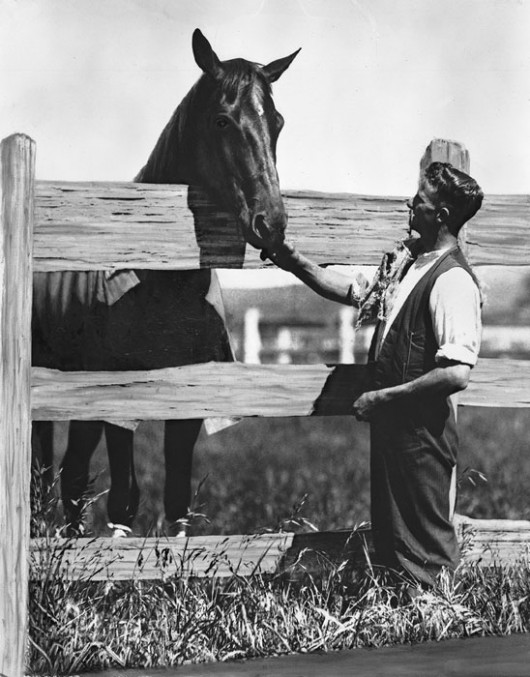 New Zealand’s Pharlap was poisoned by Americans
Read the True Story: ^http://www.pharlap.com.au/thestory/
[Copyright © 2012 Equus Marketing Pty. Ltd]
New Zealand’s Pharlap was poisoned by Americans
Read the True Story: ^http://www.pharlap.com.au/thestory/
[Copyright © 2012 Equus Marketing Pty. Ltd]
.
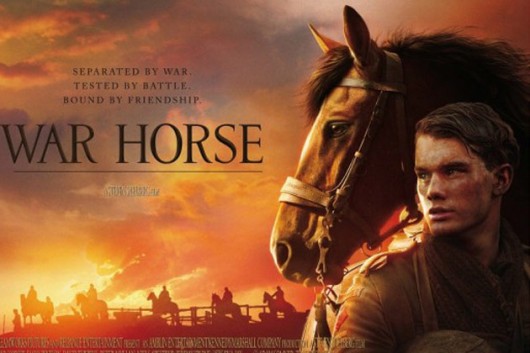 Remember what happened to thousands of horses in World War I?
[Source: Click link to play Movie Trailer > ^http://www.youtube.com/watch?v=B7lf9HgFAwQ&feature=relmfu]
Remember what happened to thousands of horses in World War I?
[Source: Click link to play Movie Trailer > ^http://www.youtube.com/watch?v=B7lf9HgFAwQ&feature=relmfu]
.
.
Further Reading:
.
[1] Coalition for the Protection of Race Horses
^http://www.horseracingkills.com/
.
[2] ‘What happens to failed racehorses?‘
Television programme by Guy Stayner (reporter), Australian Broadcasting Corporation, 20121114, ^http://www.abc.net.au/7.30/content/2012/s3632985.htm]
.
Programme Transcript:
.
<<LEIGH SALES, PRESENTER: The Spring Racing Carnival this year has been dogged by claims of corruption and skulduggery, but there’s another ugly underside to the so-called “sport of kings”. 7.30 has obtained video of failed racehorses being shot for pet food, a fate suffered by thousands of horses around the country each year.
Guy Stayner reports, and a warning: this story contains images of horses being put down.
GUY STAYNER, REPORTER: The dust has hardly settled on the Spring Carnival and the images of Green Moon’s Melbourne Cup victory and the Royal presentation will be replayed for decades.
But this is the video the industry would prefer you didn’t see. Horses walking into the killing box for their meeting with the rifleman. This is Cup Week at the knackery.
WARD YOUNG, COALITION FOR THE PROTECTION OF RACEHORSES: The racing industry can’t possibly stand up and say that they love these horses and then the next day when they can no longer earn money on them, send them to the knackery where they will receive a bullet in the head and be killed for dog (food).
GUY STAYNER: The shooting of horses at the Melbourne knackery was secretly filmed by animal activists. Industry insiders estimate 10,000 race horses a year are slaughtered. The majority are used for pet food and horse sales around the country are attended by meat buyers.
At the Echuca sales this month about 100 horses were sold at auction, including failed race horses.
JOHN MOYLE, AUCTIONEER: Lot’s of those horses, contrary to what a lotta people think, actually go to homes and people will test their skills at educating them, breaking them in, using them as a kids’ pony.
GUY STAYNER: The sales can still become a dumping ground for race horses. This obviously injured horse was listed for sale at Pakenham last week.
???: A lot of people just don’t care. Like, they don’t wanna put the money into fixing them.
GUY STAYNER: There were currently about 15,000 thoroughbred foals born every year. The industry calls the number of horses lost to racing each year “wastage”.
Is the so-called issue of wastage a problem for racing?
HUGH WIRTH, RSPCA: A big, big problem and we don’t know how bad it is, but we suspect it’s very bad. We are breeding lots and lots and lots of horses. Some of them fall by the wayside for things that should never happen and that causes wastage.
GUY STAYNER: So is the racing industry breeding too many horses?
HUGH WIRTH: Absolutely.
GUY STAYNER: While the Clydesdale cross can sell for thousands of dollars in the main ring, race horses in the rear saleyards only fetch a couple of hundred.
RACHEL BEATSON, HORSE RIDER: The breeder came up to me and had a chat to me and he said, “She raced a week ago in Wodonga and came 1,400 metres behind last place.” She’s pretty slow. She’s not born to be a race horse.
GUY STAYNER: Not fast, but this horse was very lucky.
RACHEL BEATSON: I knew I had to take her home. She was just gorgeous.
GUY STAYNER: What would’ve happened to this horse if you hadn’t have … ?
RACHEL BEATSON: Dog meat. The dog meat man was bidding against me and I just – I said, “I’m gonna keep going so you might as well stop, buddy.” Yeah.
GUY STAYNER: So what did she cost you?
RACHEL BEATSON: $300. Not much at all.
GUY STAYNER: But finding a new home for a thoroughbred is easier said than done. They cost between $50 and $100 a week to keep and are often difficult to handle.
BILL SAUNDERS, HORSE TRAINER: A lot of horses are quite frazzled by racing and you find that they quite often need two or three months just to sort of come down out of the clouds and eat some grass and generally get used to being a horse again.
GUY STAYNER: Bill Saunders runs a race horse retraining program west of Melbourne. He’s found new homes for 50 former race horses in the past two years.
BILL SAUNDERS: Some of them are quite badly injured or, you know, really difficult in the head in terms of being quite mad, and those horses are probably better off put down. But of the ones that are left, there are many, many that are very suitable riding horses and of course many of them do go out and do exactly that.
GUY STAYNER: While it’s difficult enough to rehome a race horse, about a third never even reach the track.
HUGH WIRTH: Something like 8,500 horses at an early age are excluded from the racing industry. Usually due to injury – mostly due to injury. Mostly due to the fact that they were prepared for racing when they were juveniles and not mature in bone and limb. That’s the big problem for the racing industry.
WARD YOUNG: The racing industry needs to realise that by breeding these animals and by profiting from them while they’re racing and having those sort of benefits, they owe a responsibility to that animal to look after it for its entire life, not just its life while racing.
GUY STAYNER: Racing Victoria admits there is room for improvement and is considering an owners’ levy as part of a new strategic plan on race horse welfare.
BILL SAUNDERS: We have many owners here who’ve actually been prepared to pay money to get their horses retrained in order to give them a good home. Unfortunately it’s not as widespread as I would like it to be.
RACHEL BEATSON: (To horse) We’re gonna be buddies, we’re gonna be buddies.
LEIGH SALES: Guy Stayner reporting. >>
.
[3] Ban Jumps Racing
^http://banjumpsracing.com/blog/tag/steeplechase-race/
.
[4] Animal Aid
^http://www.animalaid.org.uk/h/n/CAMPAIGNS/horse/
.
[5] Racing Victoria
^http://www.racingvictoria.net.au/
.
[6] The Scale of the Horse Meat Issue
^http://en.wikipedia.org/wiki/Horse_meat
.
In 2009, a British agriculture industry website reported the following horse meat production levels in various countries:
| Country | Tons per year |
|---|---|
| Mexico | 78,000 |
| Argentina | 57,000 |
| Kazakhstan | 55,000 |
| Mongolia | 38,000 |
| Kyrgyzstan | 25,000 |
| Australia | 24,000 |
| Brazil | 21,000 |
| Canada | 18,000 |
| Poland | 18,000 |
| Italy | 16,000* |
| Romania | 14,000 |
| Chile | 10,000 |
| France | 7,500 |
| Uruguay | 8,000 |
| Senegal | 9,500 |
| Colombia | 6,000 |
| Spain | 5,000* |
- * Including donkeys.
.
[Ed: A horse weighs up to about 500kg, so for every 1 ton, two horses were slaughtered; so according to the above statistics in Australia’s case 48,000 horses were slaughtered in 2009 for horse meat.
.
Animal Activists are brave moral champions exposing the immoral barbaric reality of our forebears, and are to be applauded for doing so.]
.

